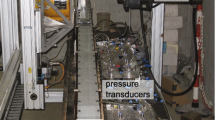Abstract
Various EOR methods lead to the appearance of specific macroscopic surfaces called interfaces of phase transition (IPT) such that the number of phases on two sides of an IPT is different, and fluids separated by an IPT are in non-equilibrium. Therefore, the flow equations are also different on two sides of an IPT and cannot be deduced from each other by a continuous degeneration, which imposes difficulties in numerical modelling. To describe such systems, we developed a new conceptual mathematical method based on the replacement of the real single-phase fluid by an imaginary multi-phase multi-component continuum having fictitious properties. As the result, the fluid over all zones becomes multi-phase and can be described by uniform multi-phase hydro- and thermodynamic equations, which allows applying the direct numerical simulation. The equivalence principle determines the physical properties of the fictitious multi-phase fluid, as well as the structure of the uniform multi-phase equations. It also proves that the saturation of each phase becomes an extended function negative or higher than unity in non-equilibrium zones, which becomes the efficient method of tracking the interfaces, the number of phases at any point, and their degree of disequilibrium. The method was developed in [1, 2] for the two-phase case. In the present paper, the new version of the method is developed for the three-phase case with gravity, diffusion, and capillarity. We have obtained the new equivalent uniform multi-phase equations which contain additional non-classical terms responsible for the diffusion and gravity across an IPT. The comparison with classical method is presented. The presentation is illustrated by several examples of simulation by means of the code developed by the research group; their concern: EOR by miscible methods and CO 2 bubble raising in aquifer.
Similar content being viewed by others
References
Abadpour, A., Panfilov, M.: Method of negative saturations for modeling two-phase compositional flow with oversaturated zones. Transp. Porous Media 79(2), 197–214 (2009)
Panfilov, M., Rasoulzadeh, M.: Interfaces of phase transition and disappearance and method of negative saturation for compositional flow with diffusion and capillarity in porous media. Transp. Porous Media 83(1), 73–98 (2010)
Entov, V.M., Zazovsky, A.: Nonlinear waves in physicochemical hydrodynamics of enhanced oil recovery, multicomponent flows, Ed. Nedra, Moscow (1997)
Orr, F.M.: Theory of gas injection processes. Ed. Stanford University, California (2002)
Bourgeat, A., Jurak, M., Smai, F.: Two-phase, partially micible flow and transport modeling in porous media; application to gas migration in a nuclear waste repository. Comput. Geosci. 13, 29–42 (2009)
Jaffré, J., Sboui, A.: Henry’s law and gas phase disappearance. Transp. Porous Media (2009)
Bonnerot, R., Jamet, P.: A conservative finite element method for one-dimensional Stefan problems with appearing and disappearing phases. J. Comput. Phys. 41(2), 357–388 (1981)
Abadpour, A.: Asymptotic analysis of the Riemann problem for compositional multiphase flow in porous media and applications to oil reservoirs. Ph.D. Thesis INPL, Nancy (2008)
Abadpour, A., Panfilov, M.: Asymptotic decomposed model of two-phase compositional flow in porous media, analytical front tracking method for Riemann problem. Transp. Porous Media 82(3), 547–565 (2010)
Oladyshkin, S., Panfilov, M.M.: Streamline splitting between thermodynamics and hydrodynamics in a compositional gas-liquid flow through porous media. Comptes Rendus Acad. Sci. Paris, Sér. IIb Mćanique 335, 7–12 (2007)
Oladyshkin, S., Royer, J.-J., Panfilov, M.: Effective solution through the streamline technique and HT-splitting for the 3D dynamic analysis of the compositional flows in oil reservoirs. Transp. Porous Media 74(3), 311–329 (2008)
Acknowledgments
The research was partially supported by the Groupement de Recherche MOMAS: Modélisation Mathématique et Simulations Numériques liées aux études d’entreposage souterrain de déchets radioactifs (CNRS, ANDRA, EDF, CEA, BRGM).
Author information
Authors and Affiliations
Corresponding author
Rights and permissions
About this article
Cite this article
Panfilov, M., Panfilova, I. Method of negative saturations for flow with variable number of phases in porous media: extension to three-phase multi-component case. Comput Geosci 18, 385–399 (2014). https://doi.org/10.1007/s10596-014-9416-0
Received:
Accepted:
Published:
Issue Date:
DOI: https://doi.org/10.1007/s10596-014-9416-0



